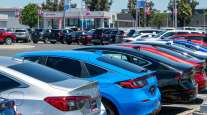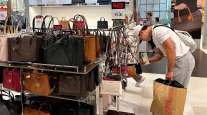Retail Sales Jump Most Since 2017 on Autos, Gasoline

U.S. retail sales jumped by the most since September 2017 as gains in motor vehicles and gasoline stations boosted sales, signaling consumers are giving the economy greater support.
The value of overall sales in March rose 1.6% after an unrevised 0.2% decrease the prior month, according to Commerce Department figures released April 18. That exceeded all forecasts in Bloomberg’s survey calling for a 1% gain.
A separate report April 18 from the Labor Department showed filings for unemployment benefits fell last week to a fresh a 49-year low. U.S. stock futures rose just after the report before paring gains.
With first-quarter gross domestic product figures due April 26, the surprisingly strong retail report may spur economists to further increase projections. Analysts raised economic growth forecasts for the period April 17 after a report showing the trade deficit unexpectedly narrowed in February.
The stronger data signal consumers may continue to drive the expansion amid solid wage gains, low unemployment, and policymakers indicating interest rates will remain on hold this year. The rebound, after a December plunge, may help offset an inventory overhang that’s poised to weigh on growth later this year.

Automobile dealer sales rose 3.1%, the most in 18 months, after a drop the prior month. Industry data from Ward’s Automotive Group previously showed unit sales rebounded in March.
Twelve of 13 major retail categories increased. Sales at clothing stores increased 2%, the most since May, while food services posted a 0.8% gain, the best since July. Nonstore retailers held up with a second straight 1.2% rise, as sporting goods and hobby stores saw the lone decline.
Federal Reserve officials, who have signaled they will remain patient on any policy rate changes amid low inflation and gathering uncertainty, will be watching for indications whether consumer spending gains are likely to be sustained over time.
Sales in the “control group” subset, which some analysts view as a cleaner gauge of underlying consumer demand, climbed 1% and topped projections. The measure excludes food services, car dealers, building-material stores and gasoline stations.
The Labor Department report showed initial jobless claims fell last week to 192,000, the lowest since September 1969. Economists had projected an increase.
Sales at filling stations increased 3.5%, in line with the prior month, the report showed, as oil prices rallied. Another Labor Department report this month showed gas prices rose 6.5% in March, the most since September 2017.




